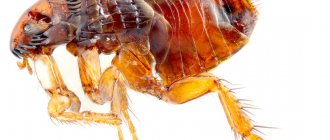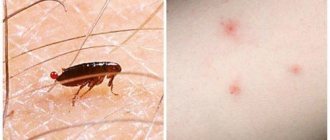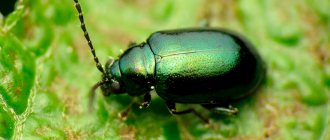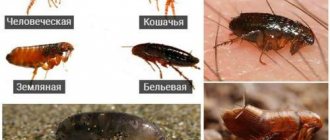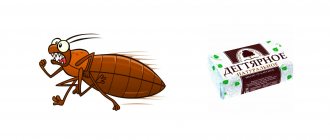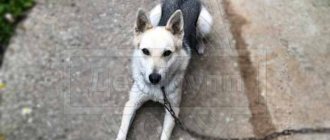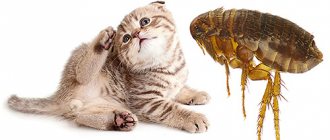Fleas can be safely described as the most annoying and widespread parasites, which consider dogs, other domestic animals, and, in the absence of such, humans as food sources. There is a widespread belief in everyday life that dogs living in outdoor conditions are especially susceptible to flea infestation.
In fact, all dogs are considered at risk, including those that live in an apartment and have virtually no contact with their brothers. When fleas appear, the animal is bothered by severe itching and pain; in addition, infection with parasites can cause the development of severe infectious diseases carried by these unpleasant insects.
If larvae and adult fleas are found on an animal's fur, for example, while bathing, you should immediately begin treating the animal. We will consider below which methods are particularly effective.
Causes of flea infestation
It is impossible to completely and forever protect a dog from parasites, because there are incredibly many possibilities for infection with them. Whether on the street or in the apartment, there are no safe places. Fleas can be found anywhere, even in the most unexpected places. But we can identify the main reasons for the appearance of “vampires” in animals:
- Any walks in nature or even around the city;
- Contact with other animals;
- Larvae.
In the first case, it is obvious that hungry insects are patiently waiting for victims. They have no preference in choosing where to ambush. Grass, foliage, and soil will do. They can be found on the playground, on sidewalks and on public transport. They are everywhere. And there is a simple explanation for this: an animal overpopulated with fleas throws off some of the parasites.
But the risk of having uncomfortable “guests” is even higher - communication between pets. A dog easily picks up fleas, even if it is half a meter away from an infected animal. There is also a risk when interacting with a completely domestic animal.
Larvae, like fleas themselves, can be everywhere. But they are the easiest to bring into a person’s house. On shoes or clothes along with dirt and stuck leaves.
Fleas are tenacious creatures. It is not difficult for them to move freely from one place to another in search of food. They can get into the house through open windows and doors, and even in women's handbags or grocery bags.
IMPORTANT: Fleas are often confused with lice. They are easy to distinguish: the body of lice is usually large and flat, and the legs are short. Fleas are brown in color and lice are grayish-white. The latter are less common, mainly in unkempt pets and stray dogs.
Flea classification
It is difficult for a non-specialist to distinguish one type of flea from another, because to the eye they look the same. But the flea classifier includes many families and species of these insects.
Most often, it is generally accepted to separate fleas according to their choice of prey: human, cat, rat, etc. There is also Ctenocephalidis Canis - this is the so-called dog flea. In fact, not only this species, but also many other species parasitize the dog.
The human flea feeds on the blood of both humans and their domestic animals. They are saturated with blood in 20 minutes, and then digest it for another six hours.
IMPORTANT: Subcutaneous fleas are a myth. There are many parasites that live under the skin, but fleas are not one of them. Duck mites are also mistakenly mistaken for fleas.
- The cat flea also parasitizes other animals and humans.
- A dog flea is similar to a cat flea, but lives a little less (six months to one and a half years). These insects are sources of flatworms and plague.
- More dangerous than the previous ones is the rat flea. She is a carrier of rat and mouse tapeworm.
- The black flea, unlike, for example, the dog flea, reproduces very quickly: the time from being in the larval stage to becoming an adult is barely four days.
- There are grass fleas that are mistaken for other species of fleas. Unlike the others, the grass one has wings, albeit barely noticeable. It is active from mid-spring to mid-summer, but there are exceptions. If you don't get rid of it in time, it can bother you all year round.
IMPORTANT: Grass fleas often inhabit vegetable gardens and eat plants. But this does not mean that they are harmless to humans and animals.
Another special species is the bed flea. Already from the name it is clear where it lives.
Read Signs of distemper in dogs: how to treat at home, types and consequences
How fleas reproduce on dogs
The peculiarity of their reproduction is that in cold weather they prefer not to mate. The ideal temperature for this is 18-25 degrees. Mating itself takes several hours, so it does not happen on the dog’s body, but somewhere in a secluded corner.
The life cycle of these bloodsuckers includes four stages:
- Egg. The female lays them little by little: only 4-8 eggs at a time. Eggs rarely remain on the pet itself; they usually fall to the floor due to their non-stickiness.
- Larva. The dog flea hatches after 8-14 days and begins to feed on the excrement of adults. She needs excrement because it contains undigested blood. Their diet also includes other waste, including rotted grass.
- Doll. After two molts, the pupa weaves a cocoon, which subsequently sticks to it. The flea remains in this stage until a victim appears nearby.
- Imago. Adult stage. Their lifespan greatly depends on the conditions in which they live. At low temperatures they live longer.
Collar
A flea collar for dogs is a strap made of porous material, impregnated with a substance that kills or repels fleas. Worn around the neck, designed to prevent the appearance of parasitic insects. It is impossible to cure an animal of fleas using this remedy alone. The fact is that the collar is intended to be worn constantly, so its impregnation contains active components in minimal quantities so as not to harm the dog’s health.
Important: collars for puppies under 2 months are not recommended.
Experts note the effectiveness of many types of collars. For example, “Fitodoc” based on natural repellents, “Rolf club 3D”, which repels almost all types of blood-sucking insects.
Symptoms and external signs
The main symptom is the dog’s anxiety: it tends to change its position while resting, twitch, and jump up. A flea-covered dog stops loving bathing. Any entry into the water evokes an irresistible desire to get out onto land.
An obvious sign is that the animal has bitten itself, scratched itself furiously, and its eyes are filled with irritation or anger.
Other signs are visible when scratching: red spots on the skin (this is not an indicator if the dog has allergies), eggs and excrement on the fur. Wounds and areas with ulcers also indicate possible infection.
Fleas bite in their favorite places - the withers, ears and stomach. That's where you should look for them first.
The danger of fleas for dogs and humans
In addition to discomfort, the dog has a risk of getting sick or becoming infected with something else. Fleas are especially dangerous due to the following consequences:
- Plague;
- Infestation by tapeworms and other parasites;
- Typhus;
- Ulcers, including anthrax;
- Allergy;
- Brucellosis;
- Listeriosis;
- Anemia;
- Fungal infections;
- Encephalitis;
- Salmonellosis.
Fleas will not spread to humans, but if they bite, they will bite. Accordingly, the owners have the same risks.
Possible consequences
Fleas not only cause discomfort to your dog, but they also carry serious diseases and parasites, such as:
- Cucumber tapeworm. The disease occurs when fleas enter the dog's digestive tract. The worms live in the pet’s body for several months and parasitize in the small intestine. Symptoms of the disease include bouts of vomiting, lack of appetite and indigestion.
- Plague. If fleas previously drank the blood of infected rodents and entered the dog’s body, then the disease cannot be avoided. The presence of this disease in a dog is indicated by fever, discharge from the eyes and enlarged lymph nodes.
- Brucellosis. This infectious disease is also transmitted when an infected flea enters the dog's digestive tract. It is practically asymptomatic, but in some cases the four-legged pet’s body temperature rises.
All of the above diseases are dangerous not only for the dog, but also for its owners. Therefore, if fleas are detected on a four-legged pet, it is necessary to immediately begin treatment.
How to remove fleas from a dog
Getting rid of them should begin immediately from the moment the “vampires” are discovered. When a dog is literally eaten by fleas, much more serious and expensive treatment may be needed.
Shampoos
Most harmless and suitable for puppies. Especially those based on natural ingredients. Insecticidal shampoos easily cause allergies.
For thorough flea removal, it is better to use something else.
Popular shampoos: “Doctor Zoo”, “Bars”, “Clandestine”, “Beaphar”, “Master Bruno”, “Lugovoy”, “Fitoelita”.
You can make your own shampoo. They do it like this: rub baby soap, pour in three glasses of water or a decoction of herbs (it can be wormwood, geranium or lavender), cook over low heat until thick, cool, add three egg yolks to everything. If desired, add essential oil (any effective one). It must be used immediately: lather and leave for ten minutes, then rinse with vinegar, strongly diluted with water.
Read Causes and treatment of persistent hiccups in adult dogs and puppies
Sprays
Among the advantages is the ability to destroy insects over a large area at once. This option is inconvenient, as it imposes some restrictions:
- After use, you must not wash your dog for two days;
- Handling must be done with gloves;
- It is necessary to ensure that the dog does not lick the product;
- It is recommended to use outdoors or in a well-ventilated area.
Popular sprays: “Bars”, “Hartz”, “Beaphar”, “Frontline”.
Drops
Flea drops have gained popularity in the market due to their strong insecticide properties. They last for about a month, protecting your pet from re-infection. Apply on the back between the shoulder blades and sacrum. As with the spray, the dog is not washed for two days.
Popular drops: “Stronghold”, “Bars”, “Practik”, “Clandestine”, “Frontline”, “Advocate”, “Blokhnet”, “Advantix”.
If a dog has fleas, along with their destruction, it is imperative to disinfect the living quarters, the pet's kennel and those areas of the house that the animal visits. Suitable for this purpose are washing floors with wormwood infusion, cleaning carpets with baking soda and table salt (tromped into the carpet and left overnight).
Chewable tablets
Lozenges and tablets are not recommended for puppies under 14 weeks of age. They contain an insecticide that enters the bloodstream. This method of control is rarely resorted to - the death of the flea does not occur immediately and the owners have no desire to feed their pets poison.
Popular tablets: Sentinel, Capstar, Bravento, Comfort, Frontline.
Anti-flea collars
This remedy has a greater advantage in prevention than in the fight against an already large mass of parasites. Chemical collars are used for control. For the prevention of pregnant dogs - ultrasound and biological. The latter contain essential oils and plant extracts.
IMPORTANT: Insecticidal collars can cause harm to the animal. They have many contraindications that you should definitely familiarize yourself with.
The peculiarity of the collars is that they can be worn from two months to six months.
Popular collars: “Clandestine”, “Beaphar”, “Leopard”, “Doctor Zoo”, “Bolfo”.
Insectoacaricide powders
A budget option, but time-consuming. Like many products used to remove fleas, these powders are toxic. The method of applying the powder depends on the instructions.
We carry out disinfection of the premises
To eliminate parasites from a dog, it is not enough to just treat the dog. The bloodsuckers that live nearby will come back again after the medicine expires. As a result, it is necessary to simultaneously clean the living quarters and the booth in which the animal lives. To disinfest an apartment, you can use one of the following methods:
- Heat treatment. In winter, things are taken out into the cold; a couple of hours are enough for the parasites to die. You can kill fleas by boiling or pouring boiling water over things.
- Chemical substances. The floor, walls, corners, utility rooms are treated with Karbofos, Reid, Fenaxin. They resort to insecticidal agents - sprays, powders, which were used to treat the animal.
- Home methods. To clean the room, use wormwood, kerosene, and pine sawdust. The death of parasites is possible with kerosene disinfestation. Using prepared decoctions and infusions from plants, wipe all surfaces in the room 2-3 times a day. Lay out the wormwood where the baseboard goes, in the corners, under the furniture. Regularly add a new portion when the previous one dries out.
- Professional services services. In difficult situations and when the methods of control used are ineffective, they turn to specialized services. Treatment by professionals involves the artificial organization of fine particles of steam that contain an insecticide. Particles settle, getting inside porous materials, causing the death of bloodsuckers.
The pet's kennel also requires treatment. The same methods are used as in the house. The animal's bedding is burned. To prevent the return of insects, wormwood and tansy are placed around the booth and in it.
To choose the right drug for bloodsuckers, it is better to consult a veterinarian. He will prescribe a remedy that will correspond to the age and other characteristics of the pet.
Folk remedies for fleas
Sometimes toxic drugs are contraindicated for a dog, for example, during pregnancy. Then it is better to resist blood sucking at home, using folk remedies.
Herbs
The best assistant here is wormwood. It is rubbed into the pet’s fur in the form of a decoction, and the floors in the house are also washed with it. An alternative is tansy.
In rare cases, they resort to celandine, but with caution - it is toxic. It is infused with vodka and dripped onto the withers. Another option: use it to rinse your pet’s fur after a bath.
Another way to use herbs: pour tansy (1/4), eucalyptus (1/4) and wormwood (2/4) with boiling water overnight. And in the morning, walk around the house with a spray bottle.
Garlic
It is crushed and strained in boiling water, rubbed into the withers, and sometimes distributed over the back. It is added to food, but in small portions, as it is poisonous to pets.
Onion
It helps well when washing if rubbed and mixed with baby soap. Together with garlic, it can be applied to the withers in the form of a paste.
Laundry soap
When there are no necessary shampoos, they resort to soap, preferably tar. You need to make sure that it does not lead to dry skin. This soap is used to wash floors and everything the dog sleeps on.
Essential oils
They are added to shampoos, combined with tar soap and applied to animal bedding. These are mainly citrus fruits, geranium, mint, lavender, cloves, anise, fir, tea tree and eucalyptus. Should be used with caution: dogs do not like strong odors.
Needles
The animal's sleeping place is filled with sawdust. They can also serve as a replacement for bedding: just fill the mattress with them.
Read Best Flea Treatments for 1, 2 or 3 Months Old Puppies
Vinegar
Suitable for small pets. The dog's entire body is sprayed with vinegar, then placed in a bag, except for the head, and kept there for about five minutes, then washed. It is necessary to ensure that the vinegar does not get into the eyes, nose and mouth of the animal and is rubbed into the roots of the fur.
For small breeds, salt is also suitable: a kilogram of salt is dissolved in a bucket of warm water, and the pet is dipped into this water for a few minutes. If desired, replace the salt with wormwood or another effective plant against fleas.
Other folk remedies include:
- Kerosene. They cannot treat the animal's body, but they can treat those places where fleas have been noticed. After rubbing kerosene into floors and other surfaces, leave it for a day, then ventilate thoroughly.
- Ammonia. They also treat the room. Ammonia is also supposed to be used to rinse the dog after bathing.
- Hellebore water. This tincture is used to treat the hair only if the dog does not have open wounds or scratches. Application to mucous membranes is not allowed.
- Hydrogen peroxide. Not suitable for show dogs, as the coat changes structure and becomes lighter. Peroxide diluted with water is applied to the wool and left for 25 minutes, then rinsed off.
- Camphor alcohol. Mix with table vinegar and a small dose of cologne. Apply before bathing, sometimes spray around the house.
- Boric acid. This relatively safe product destroys chitin, which is vital for fleas. A solution is made with this acid.
- Juniper fruits. Pour boiling water over two hundred grams and leave overnight. Used as drops against fleas.
Brief characteristics of parasites
Fleas are ectoparasites, i.e. creatures that live on the surface of the body of another living creature. Insects are small in size (up to 4 mm) with a dark body and a yellow belly.
Their body is flattened and covered with a hard shell, their long limbs are covered with bristles. Due to the structural features of the limbs (they are directed backwards), insects can jump high and easily move along the fur of the “host”.
They reproduce by laying larvae on the fur and skin of animals. These parasites can live for at least 3 years.
Prevention
To ensure that fleas visit your dog much less often, you must follow these rules:
- Periodically disinfect the room, change and wash sleeping places;
- Vacuum carpets, cracks in the floor, burn disposable dust containers, and put an anti-flea collar in a reusable one;
- Keep contact with other animals to a minimum;
- Monitor your pet's behavior;
- Brush his coat regularly, preferably with a flea comb or a metal comb with firm, fine-toothed teeth;
- Walk in specially designated areas;
- Keep calamus leaves or branches of wormwood and tansy in the corners of the house, but only if the pet does not have allergies;
- Ventilate the house in winter - fleas cannot stand the cold;
- During the summer months, wear a flea collar before going for a walk;
- Be sure to examine the dog after mating or upon returning from a show.
If fleas are found on one of your pets, you will have to treat every single one of them, even if they show no signs. This is a necessary part of prevention.
Some owners begin to fight parasites only if they have already multiplied with might and main. They believe that fighting small insects is the same as going to drink tea. Indeed, sometimes this turns out to be simple, especially if the house is small and there is only one dog living in it. But we must remember that the struggle is not always easy, and the pet can literally experience agony.
Taking flea prevention is the responsibility of every dog owner.
Drops
Flea drops for dogs are the most effective and easy-to-use remedy for killing fleas on animals. To produce drops, “shock” dosages of active substances are used that destroy or expel parasitic insects. The drops are applied to the dogs' withers, after spreading the fur.
The duration of action depends on the concentration of the active substance. To avoid re-infestation, the drug must be applied again as soon as the period of exposure to the drops after the previous application has expired. This is especially important for dogs that are often free-range.
Pet owners should remember that the amount of flea medication for dogs is calculated based on the weight of the animal being treated. An overdose can result in severe intoxication of the body.
Drops that have been successfully tested and are popular among dog breeders and recommended by veterinarians:
- "Stronghold" from the American manufacturer Zoetis. The active substance – selamectin, effectively destroys fleas and ticks at all stages of development, does not have a harmful effect on the health of the dog;
- "Bars" of domestic production. The active elements are the insecticides praziquantel and ivermectin. The drug can be used by puppies from 2 months.
Many anti-flea drops have been developed; it is impossible to list them in one article. You can choose the best option for your dog experimentally or by consulting a veterinarian.
Reviews
All this is very tedious, you need to tinker. And even neutralize the house if the dog has fleas! At first I fought with all the means I could, but they still appear from somewhere. I had to spend money on ivermectin - it is injected intramuscularly. Everything has been fine with my Gadget for several months now!
Our dog doesn't like collars. Always trying to take them off, naughty. We also tried aerosols, but then the whole apartment stank. He is allergic to pine needles, but wormwood helped. Only we didn’t just wash the floors with it, but scattered the dried stuff in the corners. No further processing is needed. Sometimes we still drip, but that's just how it is
The most effective way to kill insects
To quickly get rid of parasites, you should approach the issue comprehensively. It is recommended to use several products at once. For example, it is better to wash your dog with a special anti-parasitic shampoo. After bathing, it is recommended to rinse with a decoction of wormwood and a product based on apple cider vinegar.
If you are poisoning insects from a pet living with you in a house or apartment, then it is worth carrying out pest control. Parasites prefer to hide in carpets, upholstered furniture and other cozy places during persecution. Therefore, after treating your pet, clean the house: vacuum, beat and wash carpets and capes. It is advisable to treat the house with special products or call exterminators. If you don't do this, the insects will quickly return to your pet.

